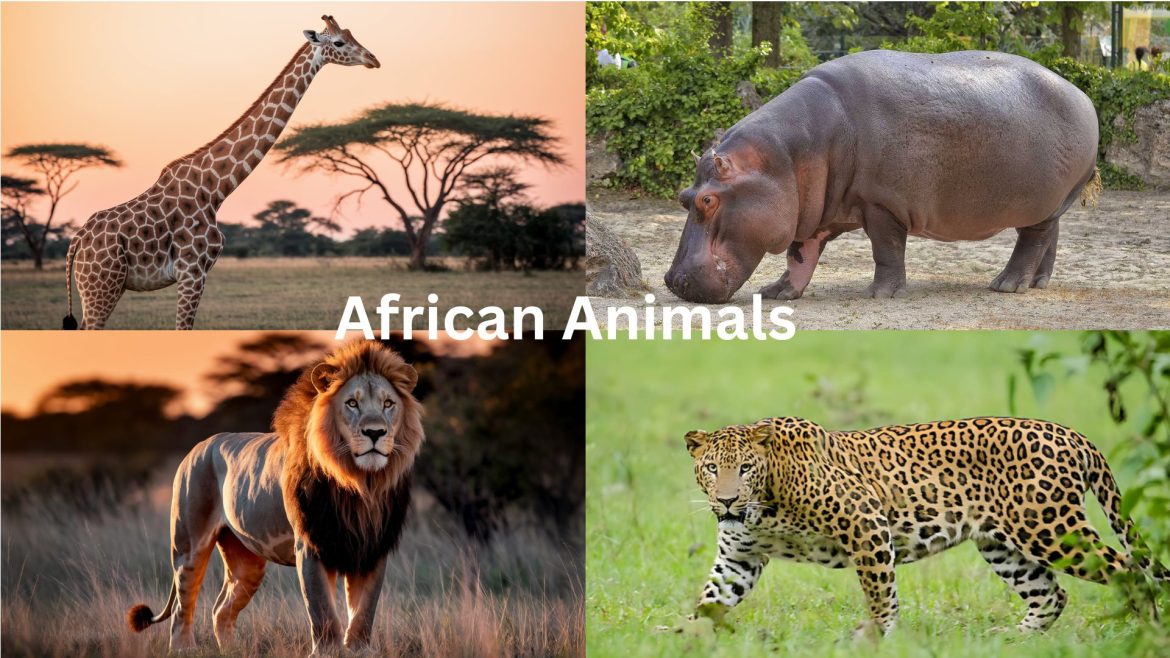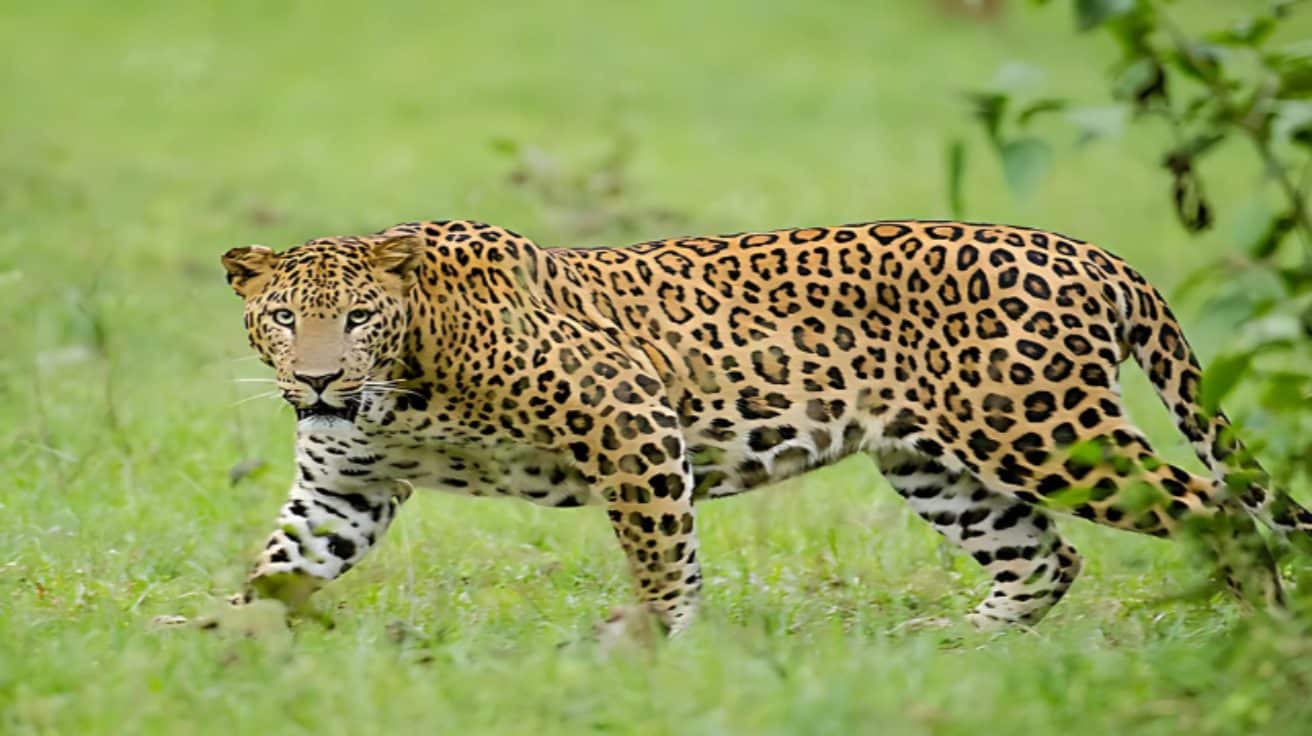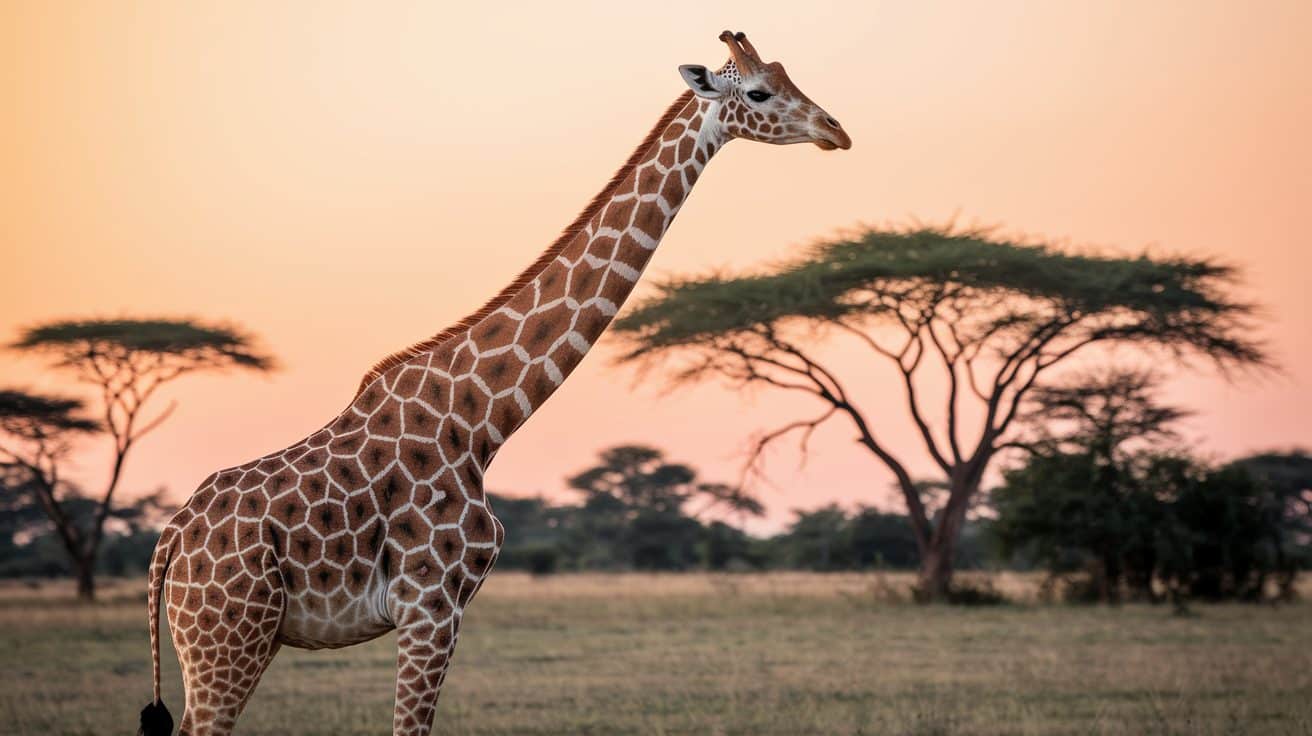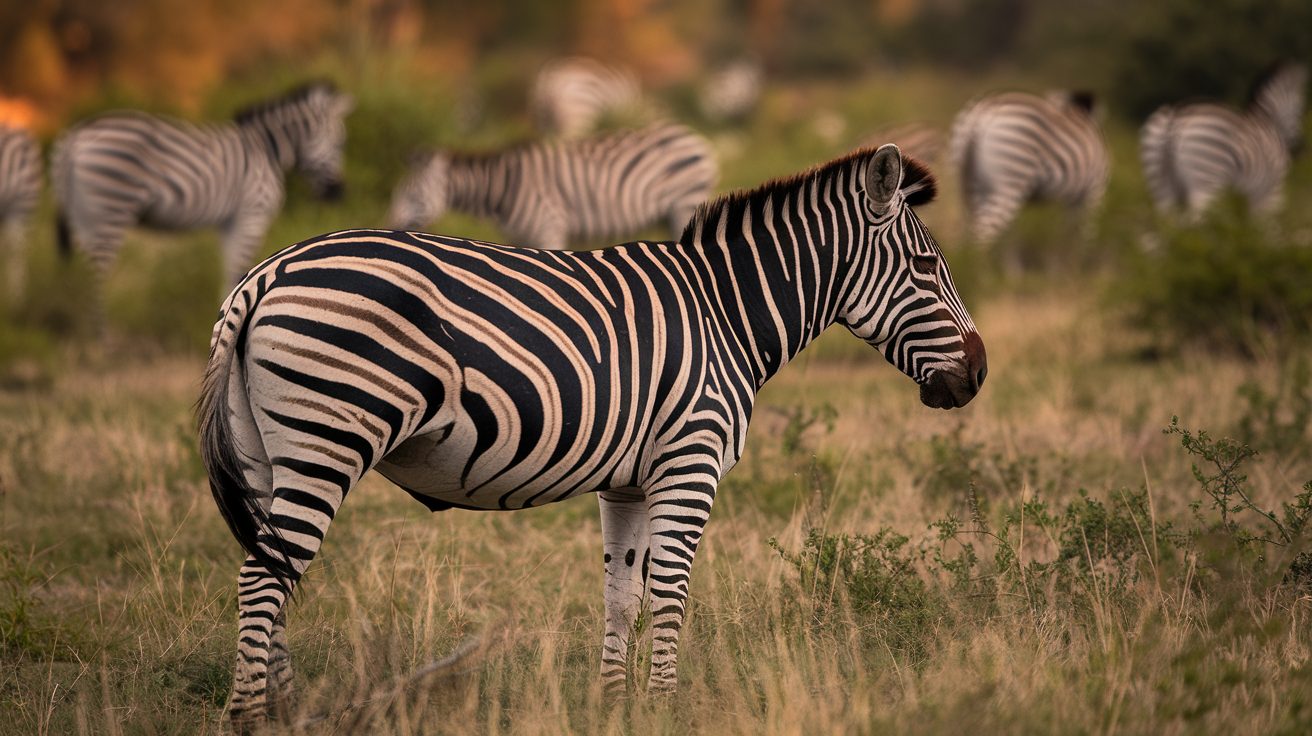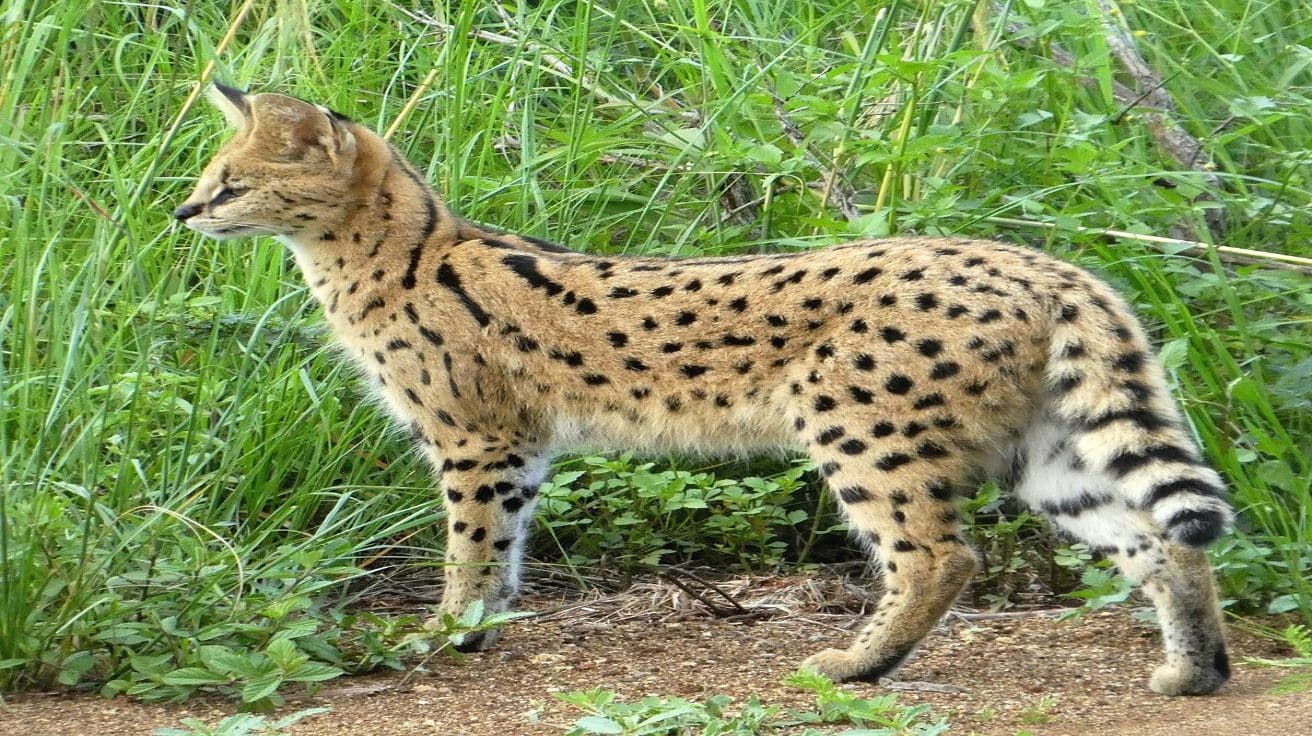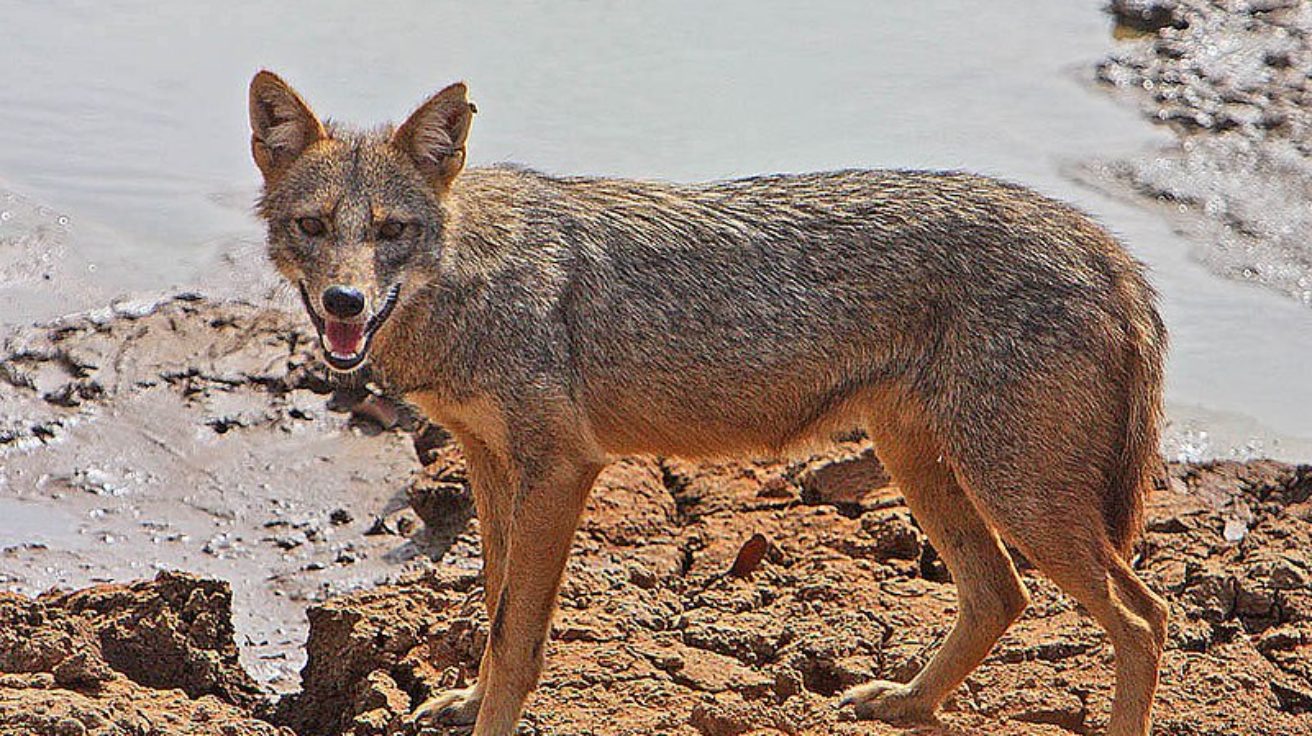Picture this: a lion’s roar echoing across the savanna at sunset, a giraffe stretching its neck to reach tender leaves, or elephants crossing dusty plains in a tight family group.
Africa’s animals capture our imagination like no other on Earth.
From the tiniest dung beetle to the mighty rhinoceros, African wildlife tells a story of adaptation, survival, and beauty. Each creature plays a unique role in one of the planet’s most diverse ecosystems.
This guide introduces you to Africa’s most interesting animals with their scientific names, origins, and surprising facts you won’t believe. You’ll find brief descriptions that bring each creature to life along with cool details about their habits and habitats.
Ready to meet some of nature’s most impressive creatures? Let’s take a walk on the wild side of Africa!
Popular African Animals
Africa boasts a remarkable variety of popular animals that are both fascinating and iconic. Below are some of the most well-known creatures, from the mighty elephant to the graceful giraffe, that define the continent’s unique biodiversity.
1. African Elephant
The African Elephant is the largest land mammal, with thick, wrinkled grey skin and pillar-like legs that support its enormous size. Its oversized ears resemble the shape of the African continent and help with heat regulation. It also features a long, muscular trunk and curved ivory tusks.
| Characteristic | Detail |
|---|---|
| Origin | Sub-Saharan Africa |
| Scientific Name | Loxodonta africana |
| Diet | Herbivore |
| Lifespan | 60–70 years |
Fun Facts
- Their trunks have over 40,000 muscles, making them incredibly strong and flexible.
- African Elephants flap their ears to cool down in hot climates.
2. Lion
Lions have a muscular, broad-shouldered build with short golden-brown fur and a tufted tail. Males are known for their thick, dark manes that vary in size and color. Their strong paws and large heads give them a dominant and powerful appearance.
| Characteristic | Detail |
|---|---|
| Origin | Sub-Saharan Africa |
| Scientific Name | Panthera leo |
| Diet | Carnivore |
| Lifespan | 10–14 years (wild) |
Fun Facts
- A lion’s roar can be heard from up to 5 miles away.
- They are the only cats that live in social groups called prides.
3. Cheetah
The cheetah has a slender, aerodynamic body with long limbs and a deep chest designed for sprinting. Its short, coarse coat is yellowish-tan with round black spots, and it has distinctive tear-like stripes running from the inner eyes down to the sides of its mouth. Its long tail helps with balance during high-speed chases.
| Characteristic | Detail |
|---|---|
| Origin | Eastern and Southern Africa |
| Scientific Name | Acinonyx jubatus |
| Diet | Carnivore |
| Lifespan | 10–12 years (wild) |
Fun Facts
- Cheetahs can reach speeds of up to 70 mph in short bursts.
- Unlike other big cats, cheetahs cannot roar.
4. Leopard
The leopard has a strong, stocky frame with short, powerful limbs and a large skull. Its fur is golden-yellow covered in distinctive black rosette spots, which help it blend into forest and savanna environments. It also has a long, thick tail that aids in balance when climbing or running.
| Characteristic | Detail |
|---|---|
| Origin | Sub-Saharan Africa |
| Scientific Name | Panthera pardus |
| Diet | Carnivore |
| Lifespan | 12–17 years |
Fun Facts
- Leopards are excellent climbers and often drag prey into trees.
- They are solitary and highly territorial animals.
5. Giraffe
Giraffes are towering animals with incredibly long necks, slender legs, and a patterned coat made up of irregular brown patches on a cream background. They have small horn-like ossicones on top of their heads and large, dark eyes framed by long lashes. Their height allows them to browse treetops for food.
| Characteristic | Detail |
|---|---|
| Origin | Savannahs of East and South Africa |
| Scientific Name | Giraffa camelopardalis |
| Diet | Herbivore |
| Lifespan | 20–25 years |
Fun Facts
- Giraffes sleep less than two hours a day, often standing up.
- Their necks contain the same number of vertebrae as humans—just much longer.
6. Hippopotamus
The hippopotamus has a huge, barrel-shaped body, nearly hairless skin with a pinkish-grey tone, and short, stumpy legs. Its massive head features wide nostrils on top, allowing it to breathe while submerged, and prominent tusks that curve upward from its lower jaw.
| Characteristic | Detail |
|---|---|
| Origin | Sub-Saharan Africa |
| Scientific Name | Hippopotamus amphibius |
| Diet | Herbivore |
| Lifespan | 40–50 years |
Fun Facts
- Hippos can hold their breath underwater for up to five minutes.
- Despite their size, they can run up to 19 mph on land.
7. Zebra
Zebras are horse-like animals with striking black-and-white stripes that are unique to each individual. Their compact bodies, short manes, and tufted tails give them a rugged, sturdy appearance. The pattern of stripes helps them blend into tall grasses and confuse predators.
| Characteristic | Detail |
|---|---|
| Origin | Grasslands and savannas of Africa |
| Scientific Name | Equus quagga |
| Diet | Herbivore |
| Lifespan | 20–30 years |
Fun Facts
- No two zebras have the same stripe pattern.
- A group of zebras is called a “dazzle.”
8. Rhinoceros (Black & White)
Rhinos are large, thick-skinned animals with massive barrel-like bodies, short legs, and two prominent horns on their snouts. The white rhino is larger and has a square lip, while the black rhino is smaller with a pointed, prehensile lip for browsing shrubs.
| Characteristic | Detail |
|---|---|
| Origin | Southern and Eastern Africa |
| Scientific Name | Diceros bicornis, Ceratotherium simum |
| Diet | Herbivore |
| Lifespan | 35–50 years |
Fun Facts
- Rhinos have poor eyesight but excellent hearing and smell.
- Their horns are made of keratin, like human fingernails.
9. African Buffalo
The African Buffalo is a large, heavily built animal with a thick neck and dark brown to black coat. It has a wide face and massive, curved horns that join in the center to form a helmet-like boss, especially prominent in males.
| Characteristic | Detail |
|---|---|
| Origin | Sub-Saharan Africa |
| Scientific Name | Syncerus caffer |
| Diet | Herbivore |
| Lifespan | 15–25 years |
Fun Facts
- African Buffaloes are considered one of the “Big Five” game animals.
- They are known for their unpredictable and aggressive behavior.
10. Wildebeest
Wildebeests are stocky antelopes with a large head, shaggy mane, and curved horns that extend sideways before bending upward. Their bodies are robust, with short necks, and they have a dark gray to brown coat with lighter vertical stripes.
| Characteristic | Detail |
|---|---|
| Origin | Eastern and Southern Africa |
| Scientific Name | Connochaetes taurinus |
| Diet | Herbivore |
| Lifespan | 15–20 years |
Fun Facts
- Wildebeests migrate in massive herds across the Serengeti.
- They can run at speeds up to 50 mph to evade predators.
11. Meerkat
Meerkats are small, slender mammals with a pointed snout, large eyes surrounded by dark patches, and a long, tapering tail. Their sandy brown fur features light stripes on the back, and they often stand upright on their hind legs to survey their surroundings.
| Characteristic | Detail |
|---|---|
| Origin | Southern Africa |
| Scientific Name | Suricata suricatta |
| Diet | Omnivore |
| Lifespan | 12–15 years |
Fun Facts
- Meerkats live in groups called “mobs” or “gangs” with strong social bonds.
- They take turns acting as lookouts to protect the group from predators.
12. Hyena
Spotted hyenas have powerful jaws, a sloping back, and coarse, short fur that ranges from light brown to grey with dark spots. They have large ears, strong necks, and are built for endurance rather than speed. Their forelimbs are longer than their hind limbs, giving them a hunched look.
| Characteristic | Detail |
|---|---|
| Origin | Sub-Saharan Africa |
| Scientific Name | Crocuta crocuta |
| Diet | Carnivore (scavenger and hunter) |
| Lifespan | 20–25 years |
Fun Facts
- Spotted hyenas have a matriarchal society where females dominate.
- Their “laughing” sound is a form of communication indicating stress or excitement.
13. Gorilla
Gorillas are the largest primates, with muscular bodies, broad chests, and long arms. Eastern gorillas tend to have darker, longer fur, while western gorillas are slightly smaller with a brownish-gray coat. Both walk on their knuckles and display immense strength.
| Characteristic | Detail |
|---|---|
| Origin | Central and East Africa |
| Scientific Name | Gorilla beringei, Gorilla gorilla |
| Diet | Herbivore |
| Lifespan | 35–40 years in the wild |
Fun Facts
- Gorillas share around 98% of their DNA with humans.
- Adult males are called silverbacks due to a stripe of silver hair on their backs.
14. Chimpanzee
Chimpanzees have long arms, opposable thumbs, and expressive faces covered with black or brown fur. Their bodies are lean and muscular, and they use their hands and feet for grasping, allowing them to skillfully climb and swing through trees.
| Characteristic | Detail |
|---|---|
| Origin | West and Central Africa |
| Scientific Name | Pan troglodytes |
| Diet | Omnivore |
| Lifespan | 33–40 years in the wild |
Fun Facts
- Chimpanzees use tools like sticks to extract termites or honey.
- They live in large social groups and communicate through gestures and vocalizations.
15. Baboon (Olive & Yellow)
Baboons are robust primates with dog-like snouts, close-set eyes, and powerful jaws. Olive baboons have a greenish-grey coat, while yellow baboons have lighter, golden fur. Both species have large buttock pads and long, expressive tails.
| Characteristic | Detail |
|---|---|
| Origin | Eastern and Central Africa |
| Scientific Name | Papio anubis, Papio cynocephalus |
| Diet | Omnivore |
| Lifespan | 30–45 years |
Fun Facts
- Baboons use more than 30 vocalizations to communicate with one another.
- They are highly adaptable and can thrive in forests, savannas, and semi-deserts.
16. Crocodile (Nile)
The Nile crocodile is a massive reptile with a broad snout, tough scaly skin, and a powerful tail. Its dark olive-brown coloration helps it blend into murky water, and its sharp teeth and strong jaw muscles make it an apex aquatic predator.
| Characteristic | Detail |
|---|---|
| Origin | Freshwater habitats across Africa |
| Scientific Name | Crocodylus niloticus |
| Diet | Carnivore |
| Lifespan | 50–70 years |
Fun Facts
- Nile crocodiles can hold their breath underwater for up to two hours.
- They use a “death roll” to tear apart prey after capturing it.
17. African Wild Dog
African wild dogs are slender, long-legged canines with large rounded ears and mottled fur in patches of black, brown, white, and yellow. Their distinct coat patterns make each dog unique, and they have a bushy white-tipped tail used for communication.
| Characteristic | Detail |
|---|---|
| Origin | Sub-Saharan Africa |
| Scientific Name | Lycaon pictus |
| Diet | Carnivore |
| Lifespan | 10–12 years |
Fun Facts
- African wild dogs are among the most efficient hunters with up to 80% success rates.
- They live in close-knit packs and care for injured or sick members.
18. Vervet Monkey
Vervet monkeys are small, agile primates with a slim body, grayish-green fur, and black faces bordered by white hair. They have long limbs and tails, allowing them to move swiftly through trees and open grasslands.
| Characteristic | Detail |
|---|---|
| Origin | Eastern and Southern Africa |
| Scientific Name | Chlorocebus pygerythrus |
| Diet | Omnivore |
| Lifespan | 12–24 years |
Fun Facts
- Vervet monkeys have different alarm calls for different predators.
- They are known to form strong bonds and live in multi-generational troops.
19. Ostrich
Ostriches are the world’s largest birds, characterized by their long necks and legs, small heads, and flightless wings. Males have bold black-and-white feathers, while females are mostly grayish-brown, providing camouflage in savannas.
| Characteristic | Detail |
|---|---|
| Origin | Across Africa’s open plains |
| Scientific Name | Struthio camelus |
| Diet | Omnivore (mostly herbivorous) |
| Lifespan | 30–40 years |
Fun Facts
- Ostriches can sprint up to 70 km/h, making them the fastest birds on land.
- They lay the largest eggs of any living bird species.
20. Flamingo
Flamingos are tall wading birds with long necks, stick-like legs, and striking pink to reddish plumage. The color comes from carotenoid pigments in their food, and they often stand on one leg in shallow waters.
| Characteristic | Detail |
|---|---|
| Origin | Lakes and wetlands in East and South Africa |
| Scientific Name | Phoeniconaias minor, Phoenicopterus roseus |
| Diet | Omnivore (algae, plankton, small invertebrates) |
| Lifespan | 20–30 years |
Fun Facts
- Flamingos use their curved beaks to filter food from muddy water.
- They often gather in colonies of thousands for breeding and protection.
21. Secretary Bird
The secretary bird is a large bird of prey with long stilt-like legs, an eagle-like head, and striking eyelashes. It has gray plumage with black flight feathers and a distinctive crest of quill-like feathers at the back of its head.
| Characteristic | Detail |
|---|---|
| Origin | Sub-Saharan Africa savannas |
| Scientific Name | Sagittarius serpentarius |
| Diet | Carnivore (mainly reptiles and insects) |
| Lifespan | 10–15 years in the wild |
Fun Facts
- Secretary birds are famous for stomping snakes to death with their strong legs.
- Despite being birds of prey, they prefer walking to flying when hunting.
22. Kudu (Greater Kudu)
Greater kudus are large antelopes with spiral horns (in males), slender bodies, and vertical white stripes across their gray-brown coats. They have large ears and manes that add to their majestic appearance.
| Characteristic | Detail |
|---|---|
| Origin | Eastern and Southern Africa |
| Scientific Name | Tragelaphus strepsiceros |
| Diet | Herbivore |
| Lifespan | 7–8 years in the wild |
Fun Facts
- A male kudu’s horns can grow up to 1.8 meters long in tight spirals.
- Kudus are excellent jumpers and can leap over fences or bushes with ease.
23. Springbok
Springboks are small, graceful antelopes with a sleek tan body, a white belly, and a dark stripe running along their sides. They have backward-curving horns and a distinctive crest on their back that rises when alarmed.
| Characteristic | Detail |
|---|---|
| Origin | Southern Africa |
| Scientific Name | Antidorcas marsupialis |
| Diet | Herbivore |
| Lifespan | 7–9 years in the wild |
Fun Facts
- Springboks can leap several meters in the air in a behavior called “pronking.”
- They can survive without drinking water, getting moisture from plants.
24. Impala
Impalas are medium-sized antelopes with reddish-brown coats, white underbellies, and slender, ringed horns in males. They are agile and fast, built for sprinting and leaping through savannas and woodlands.
| Characteristic | Detail |
|---|---|
| Origin | Eastern and Southern Africa |
| Scientific Name | Aepyceros melampus |
| Diet | Herbivore |
| Lifespan | 12–15 years |
Fun Facts
- Impalas can jump up to 3 meters high and 10 meters in distance.
- During the dry season, males gather harems and fiercely defend them.
25. Warthog
Warthogs are stocky, bristled pigs with large heads, facial warts, and curved tusks. They have sparse hair, a mane along their spine, and often kneel on their front knees to graze.
| Characteristic | Detail |
|---|---|
| Origin | Sub-Saharan Africa |
| Scientific Name | Phacochoerus africanus |
| Diet | Omnivore |
| Lifespan | 12–18 years |
Fun Facts
- Warthogs sleep in burrows, often backing in to face threats head-on.
- They can run up to 48 km/h to escape predators despite their build.
26. Serval
Servals are medium-sized wild cats with slender bodies, long legs, and golden-yellow fur covered in black spots and stripes. Their oversized ears help them detect prey in grasslands.
| Characteristic | Detail |
|---|---|
| Origin | Sub-Saharan Africa |
| Scientific Name | Leptailurus serval |
| Diet | Carnivore |
| Lifespan | 10–12 years in the wild |
Fun Facts
- Servals can leap over 2 meters into the air to catch birds in flight.
- Their hunting success rate is among the highest of wild cats.
27. Jackal (Black-backed)
Black-backed jackals are medium-sized canids with reddish-brown coats, a distinctive black “saddle” across their back, and bushy tails. They have sharp snouts and upright ears, giving them a fox-like appearance.
| Characteristic | Detail |
|---|---|
| Origin | Eastern and Southern Africa |
| Scientific Name | Canis mesomelas |
| Diet | Omnivore |
| Lifespan | 8–10 years in the wild |
Fun Facts
- Jackals are known for forming lifelong monogamous pairs.
- They often follow larger predators to scavenge leftovers.
28. Caracal
Caracals are sleek, medium-sized wild cats with short reddish coats and dramatic black ear tufts. Their muscular build and powerful hind legs allow for impressive vertical leaps.
| Characteristic | Detail |
|---|---|
| Origin | Africa, Middle East, and Central Asia |
| Scientific Name | Caracal caracal |
| Diet | Carnivore |
| Lifespan | 12–15 years in the wild |
Fun Facts
- Caracals can jump over 3 meters high to snatch birds mid-air.
- They were once trained by royals in India for bird hunting.
29. Marabou stork
Marabou storks are massive birds with bare heads, a large throat pouch, and dark back feathers. Their long, thick bills and thin legs give them a vulture-like look.
| Characteristic | Detail |
|---|---|
| Origin | Sub-Saharan Africa |
| Scientific Name | Leptoptilos crumenifer |
| Diet | Carnivore / Scavenger |
| Lifespan | 25 years in the wild, longer in captivity |
Fun Facts
- Marabou storks use thermal updrafts to soar without flapping for hours.
- They’re known as “undertaker birds” due to their gloomy appearance.
30. African fish eagle
The African fish eagle has a striking white head, dark brown body, and strong yellow beak. Its powerful talons and broad wings make it an efficient and elegant hunter.
| Characteristic | Detail |
|---|---|
| Origin | Sub-Saharan Africa near water bodies |
| Scientific Name | Haliaeetus vocifer |
| Diet | Carnivore (mainly fish) |
| Lifespan | 12–24 years in the wild |
Fun Facts
- Its loud, piercing cry is considered the “voice of Africa.”
- Fish eagles can lift prey weighing up to 2 kg right from the water.
Less Popular African Animals
While less known, Africa is home to a variety of unique and intriguing animals that are equally captivating. Below are some of these lesser-known creatures that contribute to the continent’s rich and diverse wildlife.
31. Pangolin
Pangolins are small to medium-sized mammals covered in tough, overlapping keratin scales that resemble armor. They have small heads, long tails, and a cone-shaped snout without teeth.
| Characteristic | Detail |
|---|---|
| Origin | Central and Southern Africa |
| Scientific Name | Phataginus tricuspis (tree pangolin) |
| Diet | Insectivore |
| Lifespan | Up to 20 years in captivity |
Fun Facts
- Pangolins can curl into a tight ball when threatened.
- They use their long sticky tongues to eat up to 70 million ants per year.
32. Aardvark
Aardvarks have pig-like snouts, rabbit-like ears, and strong claws for digging. Their bodies are stocky and covered in sparse grayish fur, with an arched back and thick tail.
| Characteristic | Detail |
|---|---|
| Origin | Sub-Saharan Africa |
| Scientific Name | Orycteropus afer |
| Diet | Insectivore |
| Lifespan | 10–23 years |
Fun Facts
- Aardvarks can dig a burrow in under 10 minutes.
- Their name means “earth pig” in Afrikaans.
33. Genet
Genets are slender, cat-like mammals with elongated bodies, spotted coats, and long ringed tails. They have large eyes, pointed snouts, and semi-retractable claws.
| Characteristic | Detail |
|---|---|
| Origin | Central and Southern Africa |
| Scientific Name | Genetta genetta |
| Diet | Omnivore |
| Lifespan | 8–13 years |
Fun Facts
- Genets can rotate their ankles to climb down trees headfirst.
- They are excellent night hunters with sharp senses.
34. Bushbaby (galago)
Bushbabies are tiny primates with oversized eyes for night vision, soft fur, and long tails. They have strong hind legs for leaping between trees.
| Characteristic | Detail |
|---|---|
| Origin | Sub-Saharan Africa |
| Scientific Name | Galago senegalensis |
| Diet | Omnivore |
| Lifespan | 10–16 years |
Fun Facts
- Bushbabies can jump over 2 meters in a single leap.
- They mark their territory with urine while jumping.
35. Civet
Civets are small, nocturnal mammals with long bodies, short legs, coarse fur, and facial markings similar to a raccoon. Their scent glands are highly developed.
| Characteristic | Detail |
|---|---|
| Origin | Sub-Saharan Africa |
| Scientific Name | Civettictis civetta |
| Diet | Omnivore |
| Lifespan | 15–20 years in captivity |
Fun Facts
- The musk from civets was historically used in perfumes.
- They help disperse seeds through their droppings.
36. Rock hyrax
Rock hyraxes are small, thickset mammals with short legs, rounded ears, and coarse brownish-gray fur. Despite their size, they’re closely related to elephants.
| Characteristic | Detail |
|---|---|
| Origin | East and Southern Africa |
| Scientific Name | Procavia capensis |
| Diet | Herbivore |
| Lifespan | 9–14 years |
Fun Facts
- Rock hyraxes have rubbery pads on their feet for gripping rocks.
- They communicate with over 20 different vocal sounds.
37. Bat-eared fox
Bat-eared foxes are small canines with oversized ears, narrow muzzles, and sandy-gray coats. Their ears are adapted for sound detection and body cooling.
| Characteristic | Detail |
|---|---|
| Origin | Eastern and Southern Africa |
| Scientific Name | Otocyon megalotis |
| Diet | Insectivore |
| Lifespan | 6–13 years |
Fun Facts
- Bat-eared foxes can hear termites moving underground.
- They have more teeth than any other wild canid species.
38. Bongo
Bongos are large forest antelopes with reddish-brown coats and thin white vertical stripes. Both males and females have long, slightly spiraled horns.
| Characteristic | Detail |
|---|---|
| Origin | Central and West African forests |
| Scientific Name | Tragelaphus eurycerus |
| Diet | Herbivore |
| Lifespan | 10–19 years |
Fun Facts
- Bongos are one of the heaviest forest antelopes.
- They rub mud on their horns to keep them flexible.
39. African porcupine
African porcupines are large, stout-bodied rodents with black and white quills that can reach up to 50 cm. They have strong claws and short limbs for digging.
| Characteristic | Detail |
|---|---|
| Origin | Sub-Saharan Africa |
| Scientific Name | Hystrix africaeaustralis |
| Diet | Herbivore |
| Lifespan | 15–20 years |
Fun Facts
- African porcupines do not shoot quills but release them when threatened.
- They gnaw on bones to obtain minerals like calcium.
40. African golden cat
African golden cats are medium-sized wild cats with reddish-gold to grayish coats, short tails, and tufted ears. Their muscular build helps them in forest hunting.
| Characteristic | Detail |
|---|---|
| Origin | Central and West African forests |
| Scientific Name | Caracal aurata |
| Diet | Carnivore |
| Lifespan | 12–15 years |
Fun Facts
- African golden cats are so elusive they are rarely seen in the wild.
- They are capable of taking down prey larger than themselves.
41. Zorilla (african skunk)
Zorillas are small, stout-bodied mammals resembling skunks, with black and white striped fur. Their tails are bushy, and they have strong scent glands for defense.
| Characteristic | Detail |
|---|---|
| Origin | Sub-Saharan Africa |
| Scientific Name | Ictonyx striatus |
| Diet | Omnivore |
| Lifespan | 5–8 years |
Fun Facts
- Zorillas can spray a foul-smelling substance up to 3 meters.
- They are known for their solitary and nocturnal habits.
42. Shoebill stork
Shoebill storks are large birds with massive, shoe-shaped bills, and long legs. They have a strikingly prehistoric appearance with grayish-blue feathers.
| Characteristic | Detail |
|---|---|
| Origin | East Africa |
| Scientific Name | Balaeniceps rex |
| Diet | Carnivore |
| Lifespan | 35–50 years |
Fun Facts
- Shoebills are powerful predators that hunt fish, amphibians, and reptiles.
- They can stand motionless for hours, waiting for prey.
43. Ground pangolin
Ground pangolins are armored mammals with overlapping scales made of keratin. Their long, cylindrical bodies are covered in tough, brown scales for protection.
| Characteristic | Detail |
|---|---|
| Origin | Central and West Africa |
| Scientific Name | Smutsia gigantea |
| Diet | Ants and termites |
| Lifespan | 20 years |
Fun Facts
- Ground pangolins can roll into a tight ball to protect themselves.
- They have an incredibly long tongue that can extend up to 40 cm.
44. Okapi
Okapis resemble giraffes but have shorter necks and dark, velvety coats with white stripes on their legs. Their long, flexible tongues help them grasp leaves.
| Characteristic | Detail |
|---|---|
| Origin | Democratic Republic of Congo |
| Scientific Name | Okapia johnstoni |
| Diet | Herbivore |
| Lifespan | 20–30 years |
Fun Facts
- Okapis are often referred to as “forest giraffes.”
- They have a strong sense of hearing and can detect predators from a distance.
45. Sitatunga
Sitatungas are swamp-dwelling antelopes with shaggy brown coats, long splayed hooves, and white facial markings. Males have twisted horns, while females are hornless.
| Characteristic | Detail |
|---|---|
| Origin | Central and East Africa |
| Scientific Name | Tragelaphus spekii |
| Diet | Herbivore |
| Lifespan | 12–22 years |
Fun Facts
- Sitatungas can walk on floating vegetation due to their hooves.
- They are superb swimmers and often dive when threatened.
46. Duiker (blue duiker)
The blue duiker is a small antelope with a bluish-gray coat and a white underbelly. Its small size and compact body make it agile, allowing it to move swiftly through dense forest undergrowth.
| Characteristic | Detail |
|---|---|
| Origin | West and Central Africa |
| Scientific Name | Philantomba monticola |
| Diet | Herbivore |
| Lifespan | 10–15 years |
Fun Facts
- Blue duikers are known for their quick and erratic movements when fleeing predators.
- They use dense forests to hide from predators, often remaining motionless for long periods.
47. Sun-tailed monkey
Sun-tailed monkeys are small primates with golden fur on their tails and backs, and dark faces. They have a long, slender body and are known for their agility in the trees.
| Characteristic | Detail |
|---|---|
| Origin | Central Africa |
| Scientific Name | Cercopithecus solatus |
| Diet | Fruits, leaves, and insects |
| Lifespan | 15–20 years |
Fun Facts
- Sun-tailed monkeys are very vocal, using a wide range of calls to communicate.
- They are primarily arboreal and rarely come down to the ground.
48. Naked mole rat
Naked mole rats are burrowing rodents with nearly hairless pink skin and large, protruding teeth. Their specialized social structure is similar to that of insects, like ants or bees.
| Characteristic | Detail |
|---|---|
| Origin | Eastern Africa |
| Scientific Name | Heterocephalus glaber |
| Diet | Underground plant parts |
| Lifespan | 30 years |
Fun Facts
- Naked mole rats are virtually immune to cancer.
- They live in large colonies with a single breeding female, much like social insects.
49. Maned rat
Maned rats are large, nocturnal rodents with long, thick, dark fur and a mane-like crest along their necks. They have a robust body and a large head with strong jaws.
| Characteristic | Detail |
|---|---|
| Origin | Central Africa |
| Scientific Name | Lophiomys imhausi |
| Diet | Fruits, seeds, and insects |
| Lifespan | 10 years |
Fun Facts
- Maned rats are known for their excellent climbing abilities.
- They have a strong sense of smell, which helps them find food in dense forests.
50. African clawed frog
African clawed frogs are aquatic, with smooth, olive-brown skin and three sharp claws on each hind foot. Their wide, flattened bodies help them move swiftly through the water.
| Characteristic | Detail |
|---|---|
| Origin | Sub-Saharan Africa |
| Scientific Name | Xenopus laevis |
| Diet | Insects, worms, and small fish |
| Lifespan | 15–20 years |
Fun Facts
- African clawed frogs are capable of regenerating their limbs.
- They are popular in laboratory research due to their unique biological features.
51. Red river hog
The red river hog has a distinctive reddish-brown coat with a white underbelly and facial markings. It has a robust body with long, sharp tusks and a mane that runs along its back.
| Characteristic | Detail |
|---|---|
| Origin | West and Central Africa |
| Scientific Name | Potamochoerus porcus |
| Diet | Roots, tubers, fruits, and small animals |
| Lifespan | 10–15 years |
Fun Facts
- Red river hogs are highly social animals, often seen in groups.
- Their tusks are used for digging and defending themselves against predators.
52. White-throated monitor lizard
The white-throated monitor lizard has a distinctive white throat and a long, muscular body covered with rough, scaly skin. Its sharp claws and powerful tail make it a formidable predator.
| Characteristic | Detail |
|---|---|
| Origin | Sub-Saharan Africa |
| Scientific Name | Varanus albigularis |
| Diet | Small vertebrates, insects |
| Lifespan | 20 years |
Fun Facts
- White-throated monitor lizards are excellent climbers and swimmers.
- They can run at high speeds when threatened and are skilled at hunting.
53. Elephant shrew
Elephant shrews are small, insectivorous mammals with large, rabbit-like ears and long, pointed noses. Their fur is typically brown or gray, and they have a quick, erratic movement.
| Characteristic | Detail |
|---|---|
| Origin | Sub-Saharan Africa |
| Scientific Name | Elephantulus |
| Diet | Insects, small invertebrates |
| Lifespan | 2–3 years |
Fun Facts
- Elephant shrews are not actually related to elephants, despite their name.
- They are very territorial and will mark their space with scent glands.
54. Turaco (livingstone’s turaco)
Livingstone’s turaco is a vibrant bird with striking green plumage and a distinctive white wing patch. Its long tail and unique casque on its head make it easily recognizable among African birds.
| Characteristic | Detail |
|---|---|
| Origin | Central Africa |
| Scientific Name | Tauraco livingstonii |
| Diet | Fruits, leaves, and flowers |
| Lifespan | 10–12 years |
Fun Facts
- The turaco’s green color comes from a pigment called turacins, unique to this bird.
- It is one of the few birds that can fly for short distances while also gliding.
55. Beisa oryx
The Beisa oryx has a sturdy body with a white and brown coat, adorned with dark markings across its face. It also features long, straight horns that curve back, making it a distinctive sight in the savannah.
| Characteristic | Detail |
|---|---|
| Origin | Eastern Africa |
| Scientific Name | Oryx beisa |
| Diet | Grasses, shrubs, and fruits |
| Lifespan | 18–20 years |
Fun Facts
- Beisa oryxes are known to survive long periods without water, obtaining moisture from plants.
- They are capable of running at speeds up to 65 km/h to escape predators.
It’s a Wrap!
From the powerful lions ruling the savanna to the clever meerkats standing guard in the desert, African animals show us nature at its most wonderful. Each creature has adapted in its own special way to survive and thrive.
These animals aren’t just interesting to learn about – they’re vital parts of our world. Many face threats from habitat loss and poaching, making it more important than ever to understand and protect them.
Next time you see these animals in photos, documentaries, or maybe even on safari, you’ll know the stories behind those distinctive stripes, spots, and shapes.
Our planet is home to such wonderful diversity. Let’s remember how important it is to protect these animals and their homes so future generations can enjoy them too.
What African animal would you most like to see in person? The magic of nature is waiting for you!

